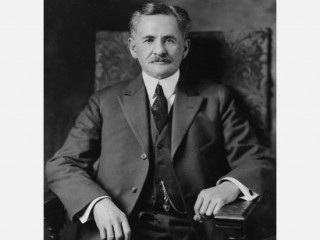
Albert Michelson biography
Date of birth : 1852-12-19
Date of death : 1931-05-09
Birthplace : Strzelno, Provinz Posen, Poland
Nationality : American
Category : Science and Technology
Last modified : 2010-11-12
Credited as : Physicist, determination of the velocity of light and the study of optical interference,
The American physicist Albert Abraham Michelsonis important for his determination of the velocity of light and the study of optical interference.
Albert Michelson was born on Dec. 19, 1852, in German Poland. The family emigrated to the United States in 1854. He took the competitive examinations for congressional appointment to the U.S. Naval Academy. Although he qualified for the appointment, the place was awarded to another boy. Young Michelson traveled to Washington, was unsuccessful in getting President Grant to appoint him to the academy, but then persuaded the commandant to accept him.
Michelson graduated from the Naval Academy in 1873. Two years later he was appointed instructor in physics and chemistry there. He resigned his commission in 1880 and spent 2 years studying in Berlin, Heidelberg, and Paris. He was then appointed to the Case School of Applied Science at Cleveland, Ohio, as professor of physics. In 1889 he moved to Clark University as professor of physics, and in 1892 he was invited to head the department of physics at the new University of Chicago, a position which he held until 1931.
With few exceptions, all of Michelson's work bore directly on problems involved in the study of light; he was thus specialized to a degree that was unique among Americans at the end of the 19th century. While serving at Annapolis, he hit upon a slight but vital modification to a method then being used to measure the speed of light. With his simple device, consisting essentially of two plane mirrors, one fixed and one revolving at the rate of about 130 turns per second from which light was to be reflected, Michelson succeeded in obtaining a measure closer than any that had been obtained to the presently accepted figure—186,508 miles per second.
Michelson performed his most famous experiment at Cleveland in collaboration with the chemist Edward W. Morley. Light waves were regarded as undulations of the ether which filled all space. If a light source were moving through the ether, the speed of the light would be different for each direction in which it was emitted. In the Michelson-Morley experiment two beams of light, sent out and reflected back at right angles to each other, took the same amount of time. Thus the notion of a stationary ether had to be discarded.
Even though his own work helped touch off a revolution in physics, Michelson never realized the fundamental nature of the change. Basically a brilliant experimenter, he saw the future development of physics only as one of further precision and newer instruments which would bring the accuracy of scientific measurements to the ultimate degree. He never understood the more mathematical and theoretical approach which came to dominate physics toward the end of his life.
Michelson's contributions were numerous. He developed, as a by-product of his interference experiments, the first spectroscope having sufficiently high resolution to disclose direct optical evidence of molecular motion; gave the scientific world a new fundamental standard of length when he calibrated the international meter in terms of wavelengths of cadmium; and, using a variation of his interferometer, became the first man to measure the diameter of a star. He received the Nobel Prize in 1907, the first American to be so honored. He died on May 9, 1931, while at work on a still more refined measurement of the velocity of light.
A good account of the major work of Michelson's life is in Bernard Jaffe, Michelson and the Speed of Light (1960). There is a useful biographical memoir of Michelson by Robert A. Millikan in National Academy of Sciences, Biographical Memoirs, vol. 19 (1938), and another profile of his life and work is in Royal Society of London, Obituary Notices of Fellows of the Royal Society, vol. 1 (1932-1935). The Nobel Foundation, Nobel Lectures: Physics, 1901-1921 (1964), has a biographical sketch.
















